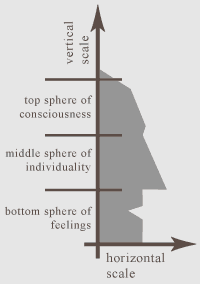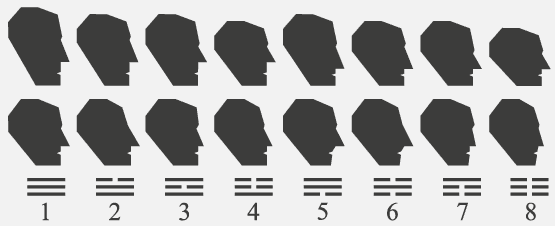-
Physiognomic sphere of feelings or sensuality.
Proportions and scale of facial sizes in physiognomy.
Three spheres of the nine-level system in physiognomy are gradation according to which sphere of consciousness (forehead and eyebrows), and/or sphere of individuality (nose bridge and nose-tip), and/or sphere of feelings (lips and chin) can be expressed in structure of a human person depending on sizes of the appropriate facial features which are considered according to a horizontal scale of measurements. But also sizes of physiognomic spheres and features of a half-face in profile can be measured according to a vertical scale of measurements, that is shown on the chart.
 |
The chart shows system of coordinates according to
which proportions of a human half-face have various sizes on vertical and horizontal scales of measurements. It is possible to tell that the horizontal scale allows to measure width of a face, and the vertical scale allows to measure height of a face in profile. Or otherwise it is possible to tell that the horizontal scale measures proportional ratio of physiognomic facial spheres and proportions of a half-face on breadth or on latitude in a lateral projection, and the vertical scale measures proportional ratio of physiognomic spheres and proportions of a human half-face on length or on longitude in a lateral projection. Divisions (units of measurements) of a horizontal scale are not shown on the chart, but about it is told on the previous page in this section of web-site. |
Proportions of a half-face and physiognomic spheres on a horizontal scale
specify the expressed and not expressed features of human character according to
which the man shows (exhibits) properties of the person, and proportions of a
half-face and physiognomic spheres on a vertical scale specify features of human
character which prevail and are dominant in structure of the person, that is
necessary for meaning at analyses of half-faces in a context of physiognomy.
Vertical and horizontal proportions of a half-face form system of coordinates
according to which it is possible to compare the expressed and not expressed
physiognomic spheres with dominant and not dominant spheres, for what it is
possible to use the following table where formal types of human faces are
systematized by means of trigrams of the canon I Ching.
 |
The expressed and dominant physiognomic spheres correspond with the entire (strong) lines in trigrams of the canon I Ching, and the not expressed and not dominant physiognomic spheres correspond with the break (weak) lines of trigrams I Ching in this table. |
The top row of images shows 8 formal types of human half-faces which have
different proportions according to a vertical scale of measurements, and the
bottom row of images shows 8 types which have different proportions according to
a horizontal scale of measurements. The bottom row of images allows to see the
expressed and not expressed physiognomic spheres, and the top row of images
allows to see dominant and not dominant physiognomic spheres, and in aggregate
two rows of images allow to correlate human half-faces to trigrams of the canon I Ching,
that as a result allows to systematize various proportional ratios which
physiognomic spheres in faces of people possess, that allows to draw
psychological conclusions.
For example, if in facial proportions of this or that man on a
vertical scale it is possible to see the dominant spheres of consciousness and individuality,
and if the sphere of feelings does not dominate, that corresponds with 5th trigram I Ching, and also if in
proportions of the half-face on a horizontal scale it is possible to see the
expressed spheres of consciousness and individuality, and if the sphere of feelings is not
expressed, that too corresponds with 5th trigram of the canon I Ching,
then it specifies the identical proportional ratio of vertical and horizontal
sizes which the human half-face possesses.
And if proportions of a human half-face have the expressed and dominant
physiognomic spheres which correspond with different trigrams of the canon I Ching then
it specifies the non-identical proportional ratio.
According to identical and non-identical proportional ratios of a face it is
possible to speak about the balanced and unbalanced features of human character,
and also it is possible to speak about proportional balance of a human person as a whole.
But it is preliminary necessary to consider proportions of vertical and
horizontal measurements for each physiognomic sphere separately.
For example, if the sphere of feelings is balanced, namely vertical and
horizontal measurements of this sphere correspond with one trigram of the canon I Ching, then it is possible to assume
that potential feelings of a man correspond with kinetic or otherwise to tell
with actual sensual displays. And if the sphere of feelings is not balanced then
it is possible to assume that potential feelings mismatch kinetic, if to
consider vertical measurements as parameters of potential characteristics, and
horizontal measurements as parameters of kinetic characteristics of a person in
a context of physiognomy. Provided that the sphere of feelings is considered as a
whole and sizes of separate levels are not taken into account. Namely lips or a
chin can be expressed or are not expressed, but if as a whole the sphere of
feelings has the balanced proportional ratio of general size on a horizontal
scale of measurements with general size on
a vertical scale of measurements then potential and kinetic characteristics are
coordinated. And if the sphere of feelings is not balanced as a whole then
potential and kinetic characteristics are not coordinated.
In a similar way it is necessary to consider physiognomic spheres of a human half-face as a
whole and to see the general proportional balance of a half-face, and then it
is possible to analyze the sizes of facial levels within the framework of spheres.
-
Physiognomic sphere of lips and chin (feelings).
The chin corresponds with reactionary feelings which are
caused by reactions of the man and are autocratic, namely are initiated by the
man or supervised by own will.
The lower lip corresponds with compromise feelings which
are caused by reactions of environmental people and are not supervised by the
man, but are comparable (conformed or adapted) or inconsistent for other sensual
subjects.
The upper lip corresponds with the regulated feelings, and
means a consensus and a coordination of feelings of many sensual subjects, or otherwise
it is possible to tell that the upper lip specifies observance of rules
according to which public expression of feelings is allowable.

|
1st physiognomic type of a facial profile. Upper lip is expressed. Lower lip is expressed. Chin is expressed. All levels of lips and chin are expressed that
means the significant expressed feelings. Namely the man has reactionary
properties according to which initiates and supervises own sensuality, and
has compromise properties according to which compares own sensuality to
feelings of environmental people. And also has ability to regulate own
sensuality in the consent with public rules that supposes public
expression of feelings, if to consider psychological meanings of facial
levels in physiognomy. |

|
2nd physiognomic type of a facial profile. Upper lip is not expressed. Lower lip is expressed. Chin is expressed. The man is capable to initiate and supervise own
sensuality according to reactionary properties, and also supposes the
compromise between expression of own sensuality and feelings which
environmental people express in relation to the man, but does not
regulate own sensuality according to the common rules and consequently
public expression of feelings is not acceptable to associates, and
accordingly the man abstains from public expression of feelings, if to
consider rules of physiognomy. |

|
3rd physiognomic type of a facial profile. Upper lip is expressed. Lower lip is not expressed. Chin is expressed. The man initiates and supervises own sensuality,
and also is capable to regulate sensuality according to the common rules
and to express publicly, but does not correlate own sensuality to feelings
of people and in essence asserts own sensuality and observes the common
rules, according to which public expression of feelings is allowable
from the point of view of associates, but does not consider or does not
understand feeling of separate people. Or otherwise it is possible to
tell that the man does not sympathize with people as compromise
properties are not significant according to physiognomy of a half-face. |

|
4th physiognomic type of a facial profile. Upper lip is not expressed. Lower lip is not expressed. Chin is expressed. The man initiates and supervises own sensuality
according to reactionary properties, but does not compare own sensuality
to feelings of people as compromise properties are not significant, and
also does not regulate feeling in the consent with the standard rules
and consequently statements of own sensuality break the common sensual
consent, if to consider physiognomy of a face in profile. |

|
5th physiognomic type of a facial profile. Upper lip is expressed. Lower lip is expressed. Chin is not expressed. The man does not initiate and does not
assert own sensuality, or otherwise it is possible to tell that expression
of feelings does not grow out own active and autocratic reactions. But the man perceives feelings of people and aspires to sensual
partnership, and also keeps the common
regulated consent according to which people express feelings and
consequently the man is capable to express the common feelings of
people according to concepts of physiognomy of a human face in profile. |

|
6th physiognomic type of a facial profile. Upper lip is not expressed. Lower lip is expressed. Chin is not expressed. The man does not express own reactionary
feelings and does not supervise own sensuality, and also does not
regulate public expression of feelings or otherwise to tell does not
feel the uniform consent of the common sensuality, but perceives
feelings of separate people and correlates own sensuality to sensual
expressions of
people. It is possible to tell that feelings of people are detached with
sensuality of the man, but the parities with sensual expressions of people are
necessary for the man in view of physiognomy of a human face in profile. |

|
7th physiognomic type of a facial profile. Upper lip is expressed. Lower lip is not expressed. Chin is not expressed. The man does not initiate and does not
supervise expression of own sensuality and consequently can coordinate
sensual expressions with the common rules according to which people express
feelings, but does not perceive feeling of separate people and
consequently supposes expression of sensuality of each person according to
the common regulated rules as reactionary and compromise properties are
not significant, but regulated properties are significant in view of
psychological meanings of facial levels in physiognomy. |

|
8th physiognomic type of a facial profile. Upper lip is not expressed. Lower lip is not expressed. Chin is not expressed. All physiognomic spheres of lips and chin
are not expressed. Feelings are not conducting parameters of the person
in a context of physiognomy. |
The word "feelings" and the derivative word "sensuality" in a context of offered
physiognomic system mean sensations and sensual perception of the world, and in
essence these words are psychological terms, and consequently it is necessary to
understand the resulted texts in view of psychological meanings. And also it is
possible to understand words "feeling" and "sensuality" in view of various
philosophical meanings.
And also words "consciousness" and "individuality" are terms which are
necessary for understanding from the point of view of philosophical and
psychological meanings which are comparable to physiognomic spheres and
levels of a human half-face, and are accordingly comparable to essence of the
man.
If figuratively to present feelings as expression of love then the essence of
reactionary and compromise and regulated feelings consists in the following.
The first physiognomic type asserts own love predilections according to
reactionary feelings and according to compromise feelings reciprocates if
someone expresses love to this type, and also this physiognomic type is capable
to show love predilections publicly as is able to regulate public expression of
sensuality.
The second physiognomic type asserts own love predilections and answers
mutual expression of love if someone expresses love to this type, but abstains
from public expression of love, namely constrains displays of sensuality if is object
of attention for many people.
The third physiognomic type asserts own love predilections, and also is capable
to express sensuality publicly or aspires to show own love if is object of public
attention, but does not express reciprocity of feelings or otherwise to tell has
no sensual attachment.
The fourth physiognomic type asserts own love predilections but does not express
mutual sensuality and does not show feeling of love publicly.
The fifth physiognomic type does not assert own love predilections, namely does
not choose object of love, but answers mutual expression of love if someone
expresses sensuality to this type, and also is capable to show feelings publicly.
The sixth physiognomic type does not assert own love predilections, and also
does not express sensuality publicly or constrains expression of feelings if is
object of public attention, but has feeling of mutual love and sensual attachment.
The seventh physiognomic type does not assert own love predilections and does
not express mutual sensuality, but is capable to express love if is object of
attention of people.
The eighth physiognomic type does not assert own love predilections, does not
express mutual feelings and does not express feeling publicly.
The listed variants, according to which physiognomic types express love, can
be equally peculiar to men and women but nevertheless for men 1st, 2nd, 3rd, 4th
types more often are characteristic, and for women 5th, 6th, 7th, 8th types more
often are characteristic.
The following page describes one more multilevel physiognomic system according to which it is possible to analyze human faces in profile in a context of physiognomy.
-